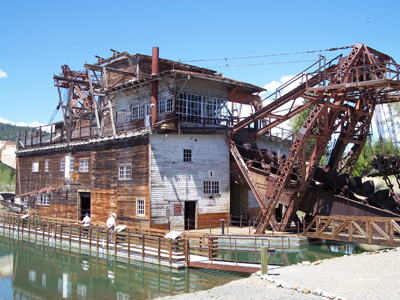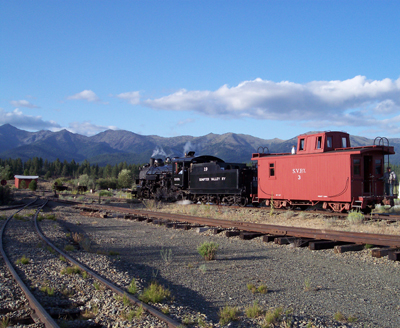Sumpter Valley Dredge State Heritage Area
When prospectors first discovered gold near Oregon's Powder River in 1862, the gold rush of eastern Oregon was on! In fact, over 10,000 mining claims were filed in Baker County during Oregon's gold rush, and boomtowns like Sumpter sprang up almost instantly. To get a sense of this area's rich history, visit the Queen City of Sumpter today. Although many private and federal mining claims still exist today, don't let that stop you from finding a fortune (or at least have fun trying) around the Sumpter area. Bring your own gold pan or detector and try your luck—just be careful not to trespass on posted claims. With the discovery of gold, the town of Sumpter got its start. By the early 1900s, numerous hard-rock mines were in operation and over 80 businesses served a population of about 3,000. The mines began to lose yield after 20 years or so, but then dredging commenced in 1913 and the townspeople prospered once again— altogether recovering over $10 million in gold. Finally in 1954, when expenses outweighed profits, the clattering of the dredge buckets was forever silenced. Mining operations ceased, folks moved on to find other jobs, and Sumpter eventually became a ghost town. The former Queen City is not completely deserted today, though. The sparse year-round population is less than 200 souls, but you'll find RV parks, restaurants, a country store and a gift shop to meet your needs. An annual flea market each Labor Day weekend brings in thousands of tourists. At the Sumpter Valley Dredge State Heritage Area located on the edge of town, step aboard the massive 1,240 ton YUBA style dredge. Not many gold dredges are still on public display, so it's fortunate this is one of the largest and most accessible in the country. Built at a cost of $350,000 in 1935, it produced $4.5 million in gold until 1954 (gold was then $35 an ounce), and was actually the third dredge to be used during that time period. It's hard to believe all that bulk actually floated on its own small pond, but that's exactly how the dredge moved from place to place—digging into the soil in a sideways pattern creating a constant pool of water that came from the Powder River. Sticking out from the dredge's hull is a massive boom bearing 72 one-ton buckets. The buckets, moving like the chain of a chainsaw, would bore into the riverbank and carry the loose rock back into the dredge interior. Once inside, the rock would pass through a series of steel cylinders to separate the material by size, sending the smaller material deeper into the dredge. Using water and sluices, the gold would be separated from the sediment. The spoils from this process and larger rock passed through the back of the dredge and were deposited behind it via another boom. The dredge ran 24 hours a day/7 days a week in all weather, requiring three shifts of about 20 men each. The workmen had just two days off each year—Christmas and Independence Day—and earnings were only 90 cents an hour for oilers and $1.10 per hour for winchmen. What a way to make a living!
After you dream of striking it rich on the dredge, ride the rails of the steam-powered train that originally hauled millions of dollars of gold ore and timber from the Elkhorn Mountains between 1890-1947. The 5-mile trip on the historic narrow gauge railroad between Sumpter and McEwen stations runs weekends and holidays from Memorial Day through the end of September. All aboard! IF YOU GO: There is no fee to visit Sumpter Valley Dredge State Heritage Area. Phone: (541) 894-2486.
Round trips on the Sumpter Valley Railroad take just over two hours, including layover. For more information call 866-894-2268. This article, written by Denise Seith, was published in the Nov/Dec 2011 issue of Gold Prospector magazine, published by the Gold Prospectors Association of America. |



